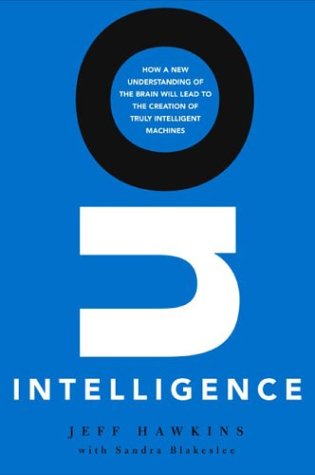 It will not be published until October 3rd, 2004, but Amazon.com has all the information on Jeff Hawkin's new book, "On Intelligence". The $25 list, 272 page book was coauthored with Sandra Blakeslee.
It will not be published until October 3rd, 2004, but Amazon.com has all the information on Jeff Hawkin's new book, "On Intelligence". The $25 list, 272 page book was coauthored with Sandra Blakeslee.
Book Description:
"From the inventor of the PalmPilot comes a new and compelling theory of intelligence, brain function, and the future of intelligent machines
Jeff Hawkins, the man who created the PalmPilot, Treo smart phone, and other handheld devices, has reshaped our relationship to computers. Now he stands ready to revolutionize both neuroscience and computing in one stroke, with a new understanding of intelligence itself.
Hawkins develops a powerful theory of how the human brain works, explaining why computers are not intelligent and how, based on this new theory, we can finally build intelligent machines.
The brain is not a computer, but a memory system that stores experiences in a way that reflects the true structure of the world, remembering sequences of events and their nested relationships and making predictions based on those memories. It is this memory-prediction system that forms the basis of intelligence, perception, creativity, and even consciousness.
In an engaging style that will captivate audiences from the merely curious to the professional scientist, Hawkins shows how a clear understanding of how the brain works will make it possible for us to build intelligent machines, in silicon, that will exceed our human ability in surprising ways.
Written with acclaimed science writer Sandra Blakeslee, On Intelligence promises to completely transfigure the possibilities of the technology age. It is a landmark book in its scope and clarity."
And an excerpt:
"Let me show why computing is not intelligence. Consider the task of catching a ball. Someone throws a ball to you, you see it traveling towards you, and in less than a second you snatch it out of the air. This doesn't seem too difficult-until you try to program a robot arm to do the same. As many a graduate student has found out the hard way, it seems nearly impossible. When engineers or computer scientists try to solve this problem, they first try to calculate the flight of the ball to determine where it will be when it reaches the arm. This calculation requires solving a set of equations of the type you learn in high school physics. Next, all the joints of a robotic arm have to be adjusted in concert to move the hand into the proper position. This whole operation has to be repeated multiple times, for as the ball approaches, the robot gets better information about its location and trajectory. If the robot waits to start moving until it knows exactly where the ball will land it will be too late to catch it. A computer requires millions of steps to solve the numerous mathematical equations to catch the ball. And although it's imaginable that a computer might be programmed to successfully solve this problem, the brain solves it in a different, faster, more intelligent way."
For those who did not know, Jeff Hawkins is director of the Redwood Neuroscience Institute.
Copyright 1999-2016 TreoCentral. All rights reserved :
Terms of Use : Privacy Policy
TREO and TreoCentral are trademarks or registered trademarks of palm, Inc. in the United States and other countries;
the TreoCentral mark and domain name are used under license from palm, Inc.
The views expressed on this website are solely those of the proprietor, or
contributors to the site, and do not necessarily reflect the views of palm, Inc.
Read Merciful by Casey Adolfsson
 It will not be published until October 3rd, 2004, but Amazon.com has all the information on Jeff Hawkin's new book, "On Intelligence". The $25 list, 272 page book was coauthored with Sandra Blakeslee.
It will not be published until October 3rd, 2004, but Amazon.com has all the information on Jeff Hawkin's new book, "On Intelligence". The $25 list, 272 page book was coauthored with Sandra Blakeslee.